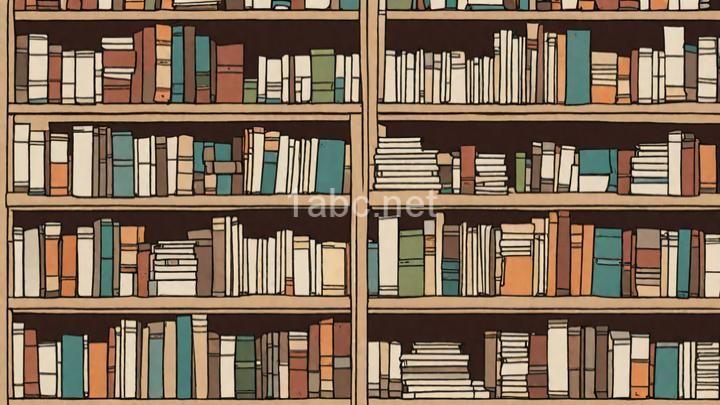Organizing and Cataloging Your Book Collection: Expert Tips and Tools

Introduction:
Are you tired of searching for hours to find that one book you want to read? Do your shelves look like chaos with books scattered haphazardly? Organizing and cataloging your book collection may seem like a daunting task, but fear not! In this blog post, we will provide you with expert tips and tools to help you transform your shelves into a well-organized treasure trove of knowledge.
I. Assessing Your Collection:
Before diving into the organization process, it's important to assess the size of your book collection and consider available storage space and shelving options.
A. Evaluating the Size:
First, determine the number of books in your collection. This will give you an idea of the magnitude of the task at hand and help you plan accordingly. If you have a large collection, you might need to allocate more time and resources for organizing.
Additionally, consider the available storage space and shelving options. Assess whether your current shelves can accommodate your entire collection or if you need to invest in additional storage solutions. This step will help you plan the layout and organization of your books effectively.
B. Sorting by Genre or Category:
Once you have assessed the size of your collection, it's time to sort your books by genre or category. Grouping books together based on their genres or categories will make it easier to find specific books later on. You can choose broad categories like fiction, non-fiction, or specific genres like fantasy, mystery, or self-help.
II. Choosing an Organizational System:
Now that your books are sorted into categories, it's time to choose an organizational system that works best for you. Here are a few popular options:
A. Alphabetical Order:
Organizing your books alphabetically is a classic and straightforward method. It allows for easy navigation and finding specific books based on the author's name or book title. However, it can be challenging to maintain if your collection keeps growing. Here are a few tips to implement this system effectively:
- Decide whether you want to organize by author's last name or book title.
- Use bookends or dividers to separate sections of the alphabet.
- Regularly update your system as new books are added to your collection.
B. Dewey Decimal System:
The Dewey Decimal System is a widely used method for organizing books in libraries. It categorizes books into ten main classes, each with its own subdivisions. While it may seem complex at first, it provides a comprehensive system for organizing books by subject matter. Here's how it can be used to organize your book collection:
- Familiarize yourself with the Dewey Decimal System and its main classes.
- Assign a specific Dewey Decimal number to each book based on its subject matter.
- Arrange your books on shelves according to their assigned numbers.
C. Chronological Order:
Organizing books chronologically can be a unique and visually appealing way to showcase your collection. It allows you to see the progression of literature over time and can be particularly useful for historical or biographical collections. Here are some suggestions for arranging your collection in chronological order:
- Start with the oldest books and work your way towards the most recent ones.
- Group books by decades or centuries, depending on the size of your collection.
- Consider adding labels or markers to indicate the time period of each book.
III. Cataloging Your Books:
Once your books are organized, it's time to create a catalog to keep track of them. Cataloging allows you to easily locate specific books and maintain an accurate record of your collection. Here are two methods for cataloging your books:
A. Manual Cataloging:
Manual cataloging involves creating a physical catalog using index cards or a notebook. Here's a step-by-step guide to help you get started:
- Assign a unique identifier or number to each book in your collection.
- Create an entry in your catalog for each book, including its title, author, publication date, and category.
- Keep your catalog organized and easily accessible, preferably near your bookshelves.
- Update your catalog whenever you add or remove books from your collection.
B. Digital Cataloging Tools:
If you prefer a more tech-savvy approach, there are several digital cataloging platforms and apps available. These tools offer features like barcode scanning, online databases, and customizable fields. Here are a few popular options:
- Goodreads: A social media platform for book lovers that allows you to create virtual bookshelves and track your reading progress.
- LibraryThing: A web-based cataloging tool that lets you create a personal library catalog, connect with other readers, and discover new books.
- Book Catalogue: An Android app that lets you scan book barcodes to create a digital catalog with detailed book information.
IV: Additional Tips for Organization Success:
A: Labeling and Tagging Systems:
Accurate labeling is essential for maintaining an organized book collection. Here's why it's important and a few tagging methods you can try:
- Labeling books accurately makes it easier to find specific books and maintain the organization of your shelves.
- Consider color coding your labels based on genres or categories.
- Use sticky notes or bookmarks to tag books that require special attention, such as books on loan or ones you plan to donate.
B: Regular Maintenance Routine:
To keep your book collection organized, establish a regular maintenance routine. Here are some guidelines to follow:
- Regularly clean and dust your shelves to keep your books in good condition.
- Set aside dedicated time for organizing and reorganizing your collection.
- Make it a habit to return books to their designated spots after reading them.
C: Avoid Common Pitfalls:
Organizing a book collection can be overwhelming, but by avoiding common pitfalls, you can make the process smoother. Here are a few mistakes to watch out for:
- Don't overcrowd your shelves. Leave room for expansion and easy browsing.
- Avoid stacking books horizontally, as it can damage the ones at the bottom.
- Don't neglect regular maintenance. Neglecting organization can quickly lead to chaos.
Conclusion:
Organizing and cataloging your book collection doesn't have to be a daunting task. By assessing the size of your collection, choosing the right organizational system, and implementing effective cataloging methods, you can transform your shelves into a well-organized treasure trove of knowledge. Remember to label your books accurately, establish a regular maintenance routine, and avoid common pitfalls. With these expert tips and tools, you'll be on your way to a beautifully organized book collection. Happy organizing!
FREQUENTLY ASKED QUESTIONS
How can I effectively organize my book collection?
Organizing a book collection can be a fun and rewarding task. Here are some steps you can take to effectively organize your books:
-
Assess your collection: Start by taking inventory of all the books you have. Determine if there are any duplicates, books you no longer want, or books that are in poor condition and need to be replaced.
-
Sort by genre or theme: Group your books based on their genre or theme. This can make it easier to find specific books when you're in the mood for a particular type of reading.
-
Alphabetize by author or title: Once you've sorted your books into genres or themes, consider alphabetizing them by either the author's last name or the book title. Alphabetization helps you easily locate books when searching for a specific author or title.
-
Consider using bookshelves or storage solutions: Invest in bookshelves or storage solutions that suit your space and style. Bookshelves not only provide a dedicated place for your books but also add a decorative element to your space.
-
Create a catalog or digital record: Keep track of your collection by creating a catalog or digital record. This can include details such as the book's title, author, genre, and location on your bookshelf. Utilize online platforms or apps designed for book cataloging to make this process easier.
-
Utilize labels or stickers: Labeling your books or bookshelves can further enhance organization. Use labels or stickers to indicate genres, authors, or any other categorization system you choose.
-
Regularly review and update: As you acquire new books or your reading preferences change, it's important to regularly review and update your organization system. This ensures that your collection remains organized and easy to navigate.
Remember, organizing your book collection is a personal endeavor, and there is no one-size-fits-all approach. Feel free to customize these suggestions to suit your preferences and make the process enjoyable. Happy organizing!
What are some tips for cataloging my book collection?
Cataloging a book collection can be a fun and rewarding task. Here are some tips to help you get started:
-
Decide on a cataloging system: Choose a method that works best for you. You can opt for a digital system using software or apps specifically designed for cataloging books, or you can go with a more traditional approach using index cards or a spreadsheet.
-
Sort and organize your books: Before you start cataloging, it's helpful to sort your books by genre, author, or any other criteria that makes sense to you. This will make it easier to locate and categorize your books during the cataloging process.
-
Gather necessary information: For each book, gather important details such as the title, author, publication date, edition, and ISBN number. You can find most of this information on the book's cover or copyright page. Note down any additional information you find relevant, such as the condition of the book or any special features it may have.
-
Use consistent formatting: When entering book information into your catalog, make sure to use consistent formatting. This will help maintain clarity and uniformity throughout your collection. Decide on a style guide for things like capitalization, punctuation, and abbreviations, and stick to it.
-
Assign unique identifiers: To easily locate and track your books, assign each one a unique identifier, such as a barcode or a custom number. This will make it easier to update your catalog and find specific books when needed.
-
Include additional information: Consider adding additional information to your catalog, such as personal notes, reviews, or your own rating system. This will allow you to personalize your collection and make it even more meaningful to you.
-
Regularly update your catalog: As you acquire new books or make changes to your collection, remember to update your catalog accordingly. By keeping your catalog up to date, you'll always have an accurate record of your book collection.
Remember, the goal of cataloging your book collection is to make it easier to manage and enjoy your books. Have fun organizing your collection and happy cataloging!
How should I categorize my books?
When it comes to categorizing your books, there are a few approaches you can take. The most common method is to organize them by genre or subject matter. This allows you to easily find books on specific topics when you need them. You can create broad categories like fiction, non-fiction, history, self-help, etc., and then further subdivide them if needed.Another approach is to organize your books alphabetically by author's last name. This can be helpful if you have a large collection and want to quickly locate books by a specific author.
If you prefer a more personalized approach, you can categorize your books based on your own interests or preferences. For example, you could create categories like "favorites," "classics," "to-read," or even organize them by mood or theme.
Ultimately, the best method for categorizing your books is the one that works best for you and allows you to easily find and enjoy your collection. So take some time to consider what approach fits your needs and start creating your own unique book organization system.
Should I consider using bookshelf labels or tags?
When deciding whether to use bookshelf labels or tags, there are a few factors to consider. Both options can be helpful in organizing your books and making it easier to find what you're looking for. Bookshelf labels are typically small stickers or tags that you attach to the spine or cover of each book. They often include information such as the genre, author, or subject of the book. This can be especially useful if you have a large collection or if you frequently lend out books to others. With bookshelf labels, you can quickly locate a specific book without having to search through each one individually.
On the other hand, bookshelf tags are larger and more visible, often hanging from the shelves themselves. These tags can provide a broader overview of your book collection, allowing you to categorize and group books by themes or interests. They can also serve as a visual reminder of what types of books you have and can be a great conversation starter for guests.
Ultimately, the decision between bookshelf labels and tags depends on your personal preference and the specific needs of your book collection. If you value a more detailed organizational system and want to quickly locate specific books, labels may be the way to go. If you prefer a more visual and aesthetically pleasing approach, tags might be a better fit.
Consider your own organizational style and the size of your collection when making this decision. And remember, there's no right or wrong answer here. The most important thing is to choose a system that works for you and helps you enjoy and access your books more easily.

